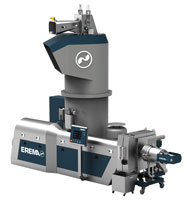
Following, what it says was the huge interest generated by the presentation of Intarema at the K2013 show in Düsseldorf, Germany, recycling system manufacturer Erema will be presenting its latest plant generation featuring the core Counter Current technology at Chinaplas 2014 in Shanghai. An Intarema 1108 T system will be on show for the Asian market, boasting an output of 600 kg/hour when processing BOPP.
With the patented Counter Current system, the central core technology of the new Intarema, Erema says it set another milestone in the plastic recycling systems in 2013. The innovation is in the interface area of the cutter/compactor and extruder. To date the worldwide technical standard has been a system in which the material in the cutter/compactor moved in the direction of the extruder. The difference with the Counter Current system is that the material spout in the cutter/compactor is now reversed and thus moves against the direction of the extruder. The result of this inverse-tangential configuration is increased process stability and, at the same time, considerably higher throughput.
With over 30 years of success, more than 4,000 systems in operation throughout the world and a notable list of references, Erema has been regarded as the global market and innovation leader in plastic recycling systems for years. Erema's technology has become established as a leading global standard for a wide variety of recycling tasks, ranging from the recycling of polyolefins to polyester (PET).
The Erema story began with a vision when it was founded in the year 1983 – to specialise in the development and manufacturing of plastic recycling systems and technologies for the plastics processing industry.
Erema managed the major breakthrough with the first generation of systems launched in 1983, the year it was founded. The company combined for the first time ever a cutter/compactor with a – back then still radial – extruder and thus made it possible (also for the first time) to cut, compact and extrude waste plastic in a single, continuous process. "Waste" was transformed into high-quality recycled pellets – a valuable secondary raw material. The machines were straightforward to operate, had low space requirements and consumed on average 30% less energy compared to the competition at that time. Major importance was attached to this new technology for the economic recycling of thermoplastics (especially very light plastics) within a very short time.
Erema continued to develop this technology and with the launch of the second plant generation in 1993 once again brought about an advancement in the industry on a large, almost dramatic scale. Thanks to the extruder now being located tangentially to the cutter/compactor, Erema was able to enhance the quality of the end products enormously while increasing output and performance considerably, too.
Additionally, a newly defined and optimised scaling of the cutter/compactor in relation to the screw diameter of the tangentially connected extruder made feeding even easier with very large individual portions and optimised material preparation for the extrusion process. Furthermore, it was possible to direct the preheated material to the extruder with much more homogeneous temperature distribution, thanks particularly to the longer residence times in the large cutter/compactor. This technology has since become a genuine all-round talent and has now culminated in the inverse-tangential configuration of the new development Intarema. The groundbreaking new feature can be seen in its name, which comes from Inverse + Tangential + Erema and is based on the newly developed and globally patented Counter Current technology.
(PRA)

















